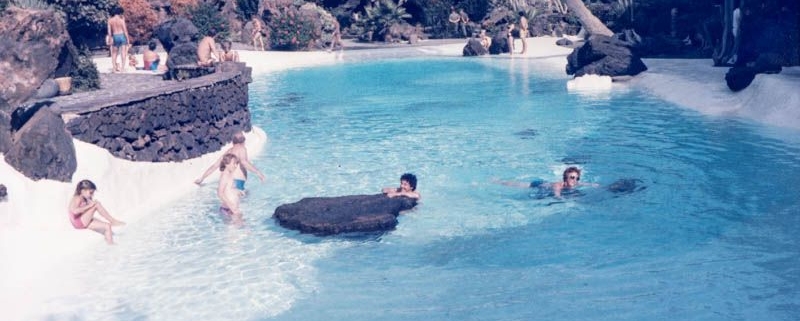MEMORIA DIGITAL de LANZAROTE expands its collection of old images of the island
MEMORIA DIGITAL de LANZAROTE
expands its collection of old images of the island
By Norman Warwick
Among the latest additions to the Memoria Digital de Lanzarote are the series of films in super 8 format shot in Lanzarote and La Graciosa by amateur filmmaker Roberto Rodríguez in the 1970s
The web portal Memoria Digital de Lanzarote, which manages the Cabildo Data Center, is carrying out an expansion of its collection of old images of the island in both photographic and film material
This service aims to “recover and disseminate the audio-visual and documentary heritage of Lanzarote and La Graciosa”, and is integrated into the area coordinated by the Minister Myriam Barros.
Barros has expressed his gratitude “to institutions and individuals who have given or donated their images, enriching the Digital Memory project of Lanzarote and contributing to the rescuing of the past of the island to make it available to citizens”.

Among the latest additions to www.memoriadelanzarote.com it is worth mentioning the series of films in super 8 format shot in Lanzarote and La Graciosa by the amateur filmmaker Roberto Rodríguez in the 1970s, and which have been loaned by the Cabildo de La Palma
Likewise, the Cabildo points out that new domestic films shot by individuals from the island such as Ventura Acuña, Manuel Perdomo, Julián Martín and Juan Luz have been uploaded, and the integration into the donation portal of homemade films such as those of Amelia Díaz, the Pérez Niz family, etc. is being carried out, as well as material from videos in VHS format provided by Juan Parrilla and Francisco Hernández, that collect interesting social aspects of the island.

The digitization of the video collection in VHS format of the Cabildo de Lanzarote collects the cultural activity that took place on the island in the 1980s, among which are the performances of international music and dance groups that took place in the auditorium of Jameos del Agua stand out
The Moscow Choir, the New York company Momix Dance, the prestigious jazz trio of Teté Montoliu, etc. appear performing in this emblematic space that had been inaugurated a few years earlier, in 1977. All this material is being documented and gradually incorporated into the Digital Memory portal of Lanzarote.

In addition, the digitization will be carried out shortly, after an agreement with the Ministry of Culture, of part of the fund of the defunct television network Lanzarote Television, which is deposited in the Archive of Teguise after having been donated by the property. Likewise, in the near future the film material of Lanzarote will be incorporated -almost all shot in the 1960s- donated by the Audiovisual Culture Center of Gran Canaria, with which a collaboration agreement has been initiated.
On the other hand, donations have recently been received from the very large film fund of Ángel Hernández, who was a cameraman of Spanish Television in Lanzarote since the 1990s, as well as from part of the fund of the defunct station Archipiélago Televisión, ceded by Corporación Lanzaroteña de Medios S.L.
The portal of the Cabildo de Lanzarote, which manages the Data Center, is also making available to the public new collections of prestigious professional photographers who travelled to Lanzarote in the mid-twentieth century, among which is Nicolás Muller (1913-2000), whose digital fund has been transferred to the Cabildo de Lanzarote by the Regional Archive of the Community of Madrid.
The images made by Muller on the island, which can be seen in www.memoriadelanzarote.com, correspond to his professional facet as a documentary photographer, collecting ethnographic and architectural aspects of the rural and fishing world of the 1960s.
Another relevant collection that has been incorporated into the portal is that of the archaeologist Luis Diego Cuscoy (1907-1987), which has been donated by the Archaeological Museum of Puerto de la Cruz (Tenerife) and which contains photographs taken by the author on his visits between 1950 and 1970.
It is also worth mentioning the donations to the Digital Memory of Lanzarote project by private individuals such as Domingo Pérez, Manuel Rodríguez, Nieves Fajardo, Eleuterio Oliva, Cleofé Acuña, etc. or the extensive collection of the collector Carlos Rojano, which includes an interesting series of images taken by an anonymous Swiss tourist, or the extensive collection donated by british travelers William and Vera Oswald who visited the island in the 1980s.
In this sense, from the Cabildo de Lanzarote an appeal is made to all those people who wish to digitize their photographs, videos, films of the island prior to the year 2000 to contact the project through the email datos1@cabildodelanzarote.com, by calling 928 81 01 00 (extension 3000) or by going directly to La Casa Amarilla, located in Calle León y Castillo number 6 of Arrecife.
This seems like a real opportunity for anyone with an interest in the history of the island to contribute to the preserving of that history wehilst at the same time updating fading photographic memories into vivid VHS:
this all offers more food for thought, perhaps, for Dr. Bennsman and his fellow residents at ShangriLa Park, Playa Blanca ! Surely, id Shangrila Park could create its own smaller, but similar project, along with other new resident settlementsd, they could complement and even enhance what is being done by a similar by Digital Memoria de Lanzarote.
The visiting tourists and new residnets to arrive here over the last fity years have surely affected both the geographical and cultural landscape with new buildings, new cultural attitudes and have contributed to the economic growth of the isdand, all of which could be reflected in potted histories that would create an even more comprehensive recent history of the island on which I feel most welcome and free to share.




Leave a Reply
Want to join the discussion?Feel free to contribute!